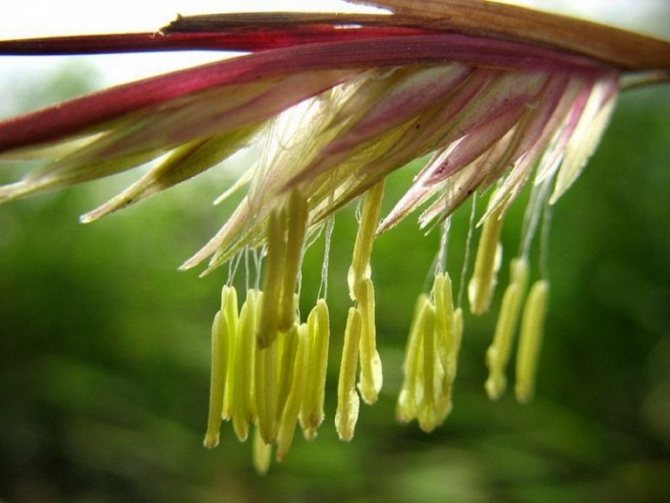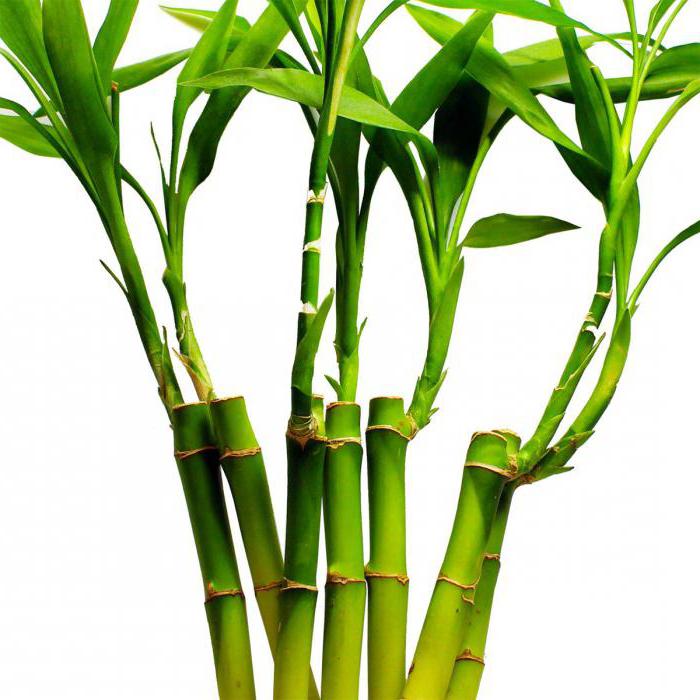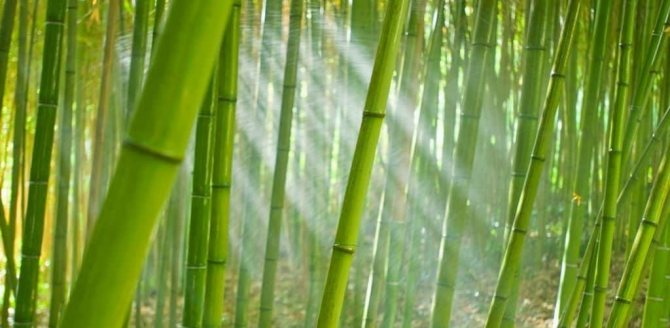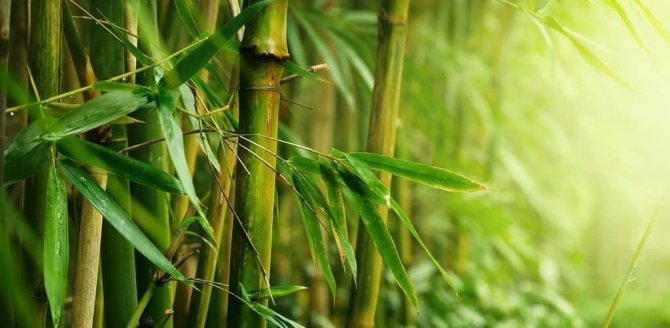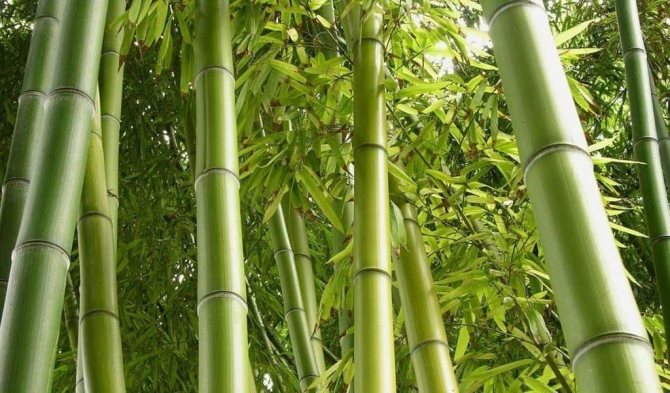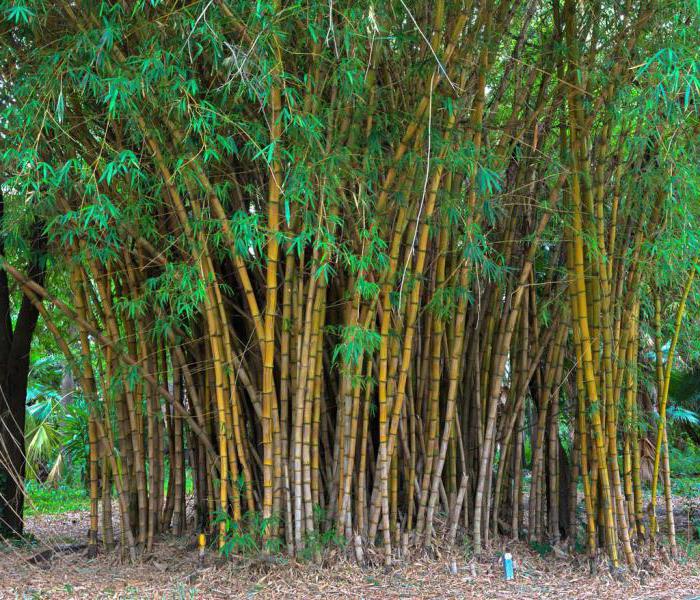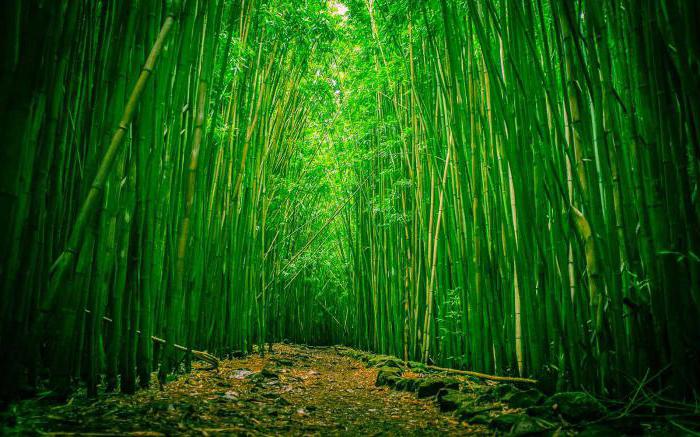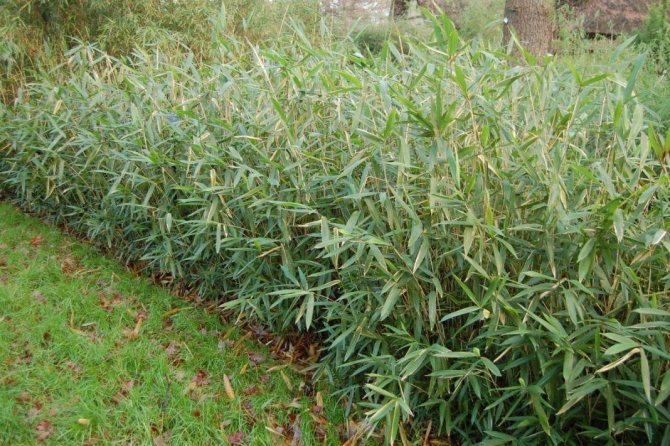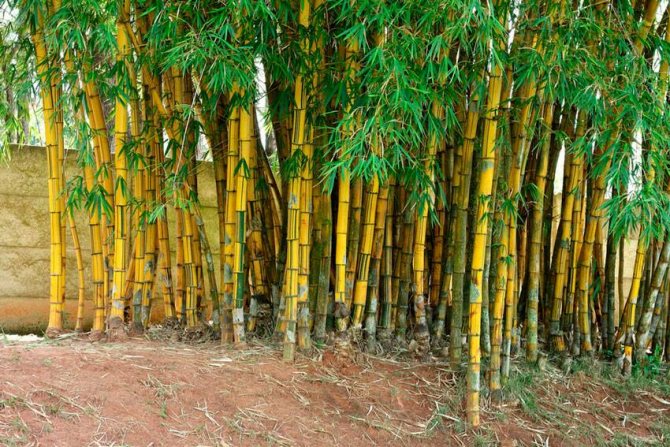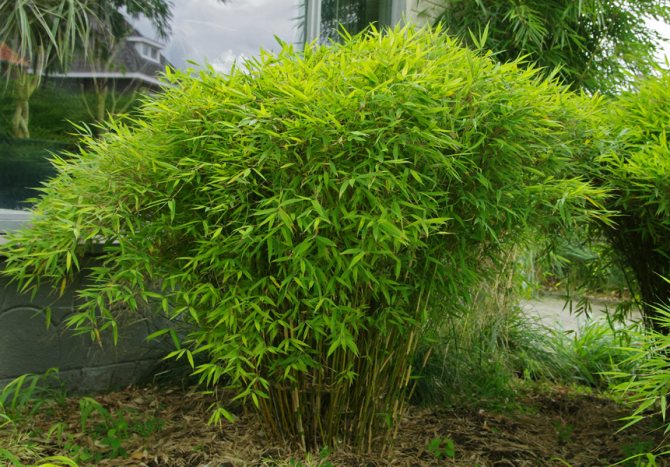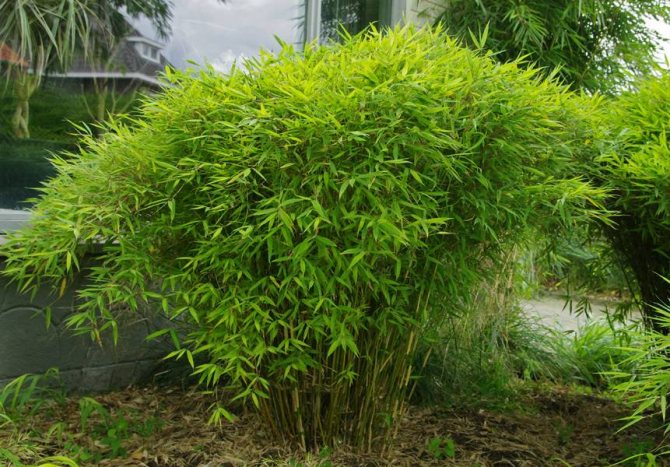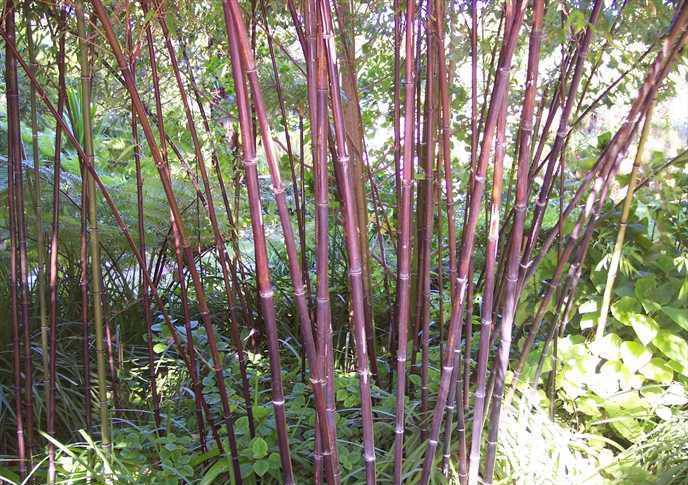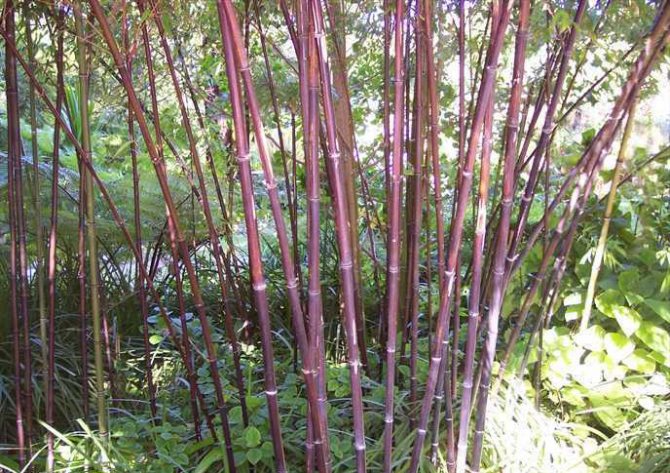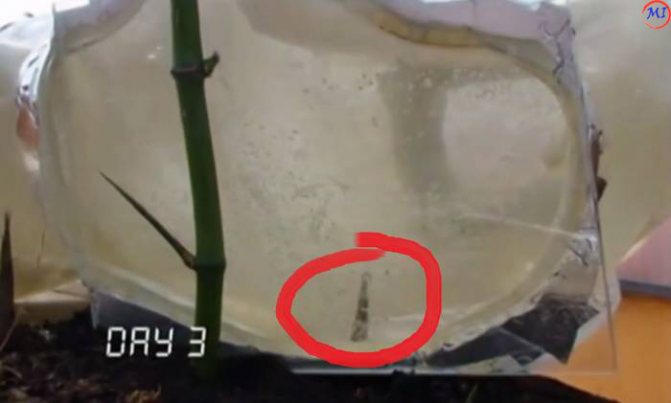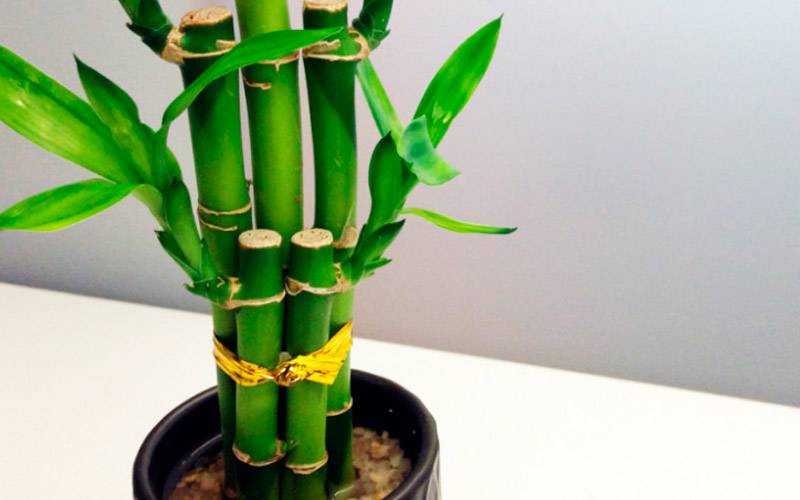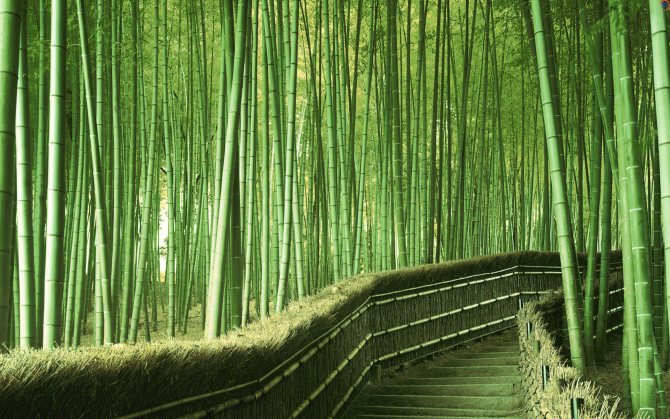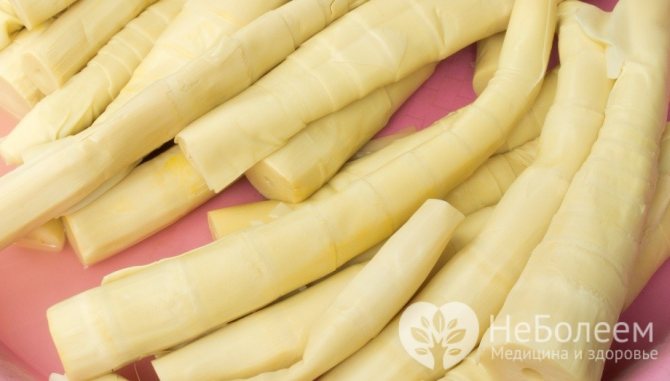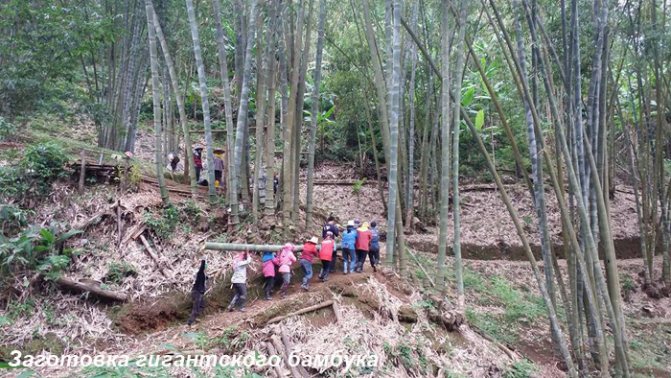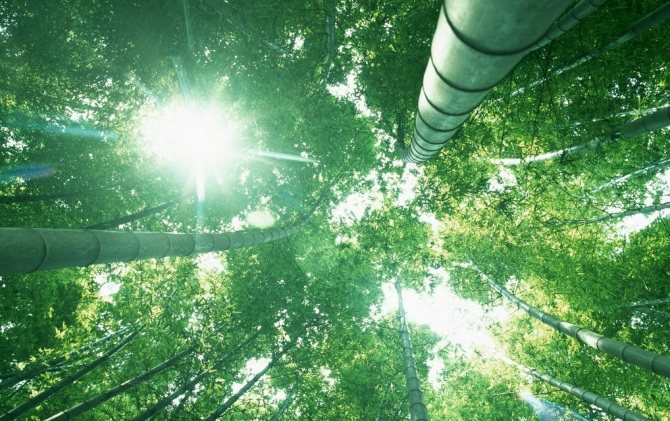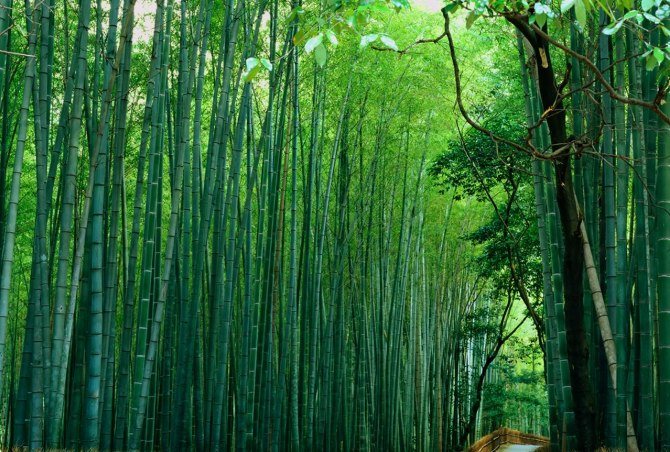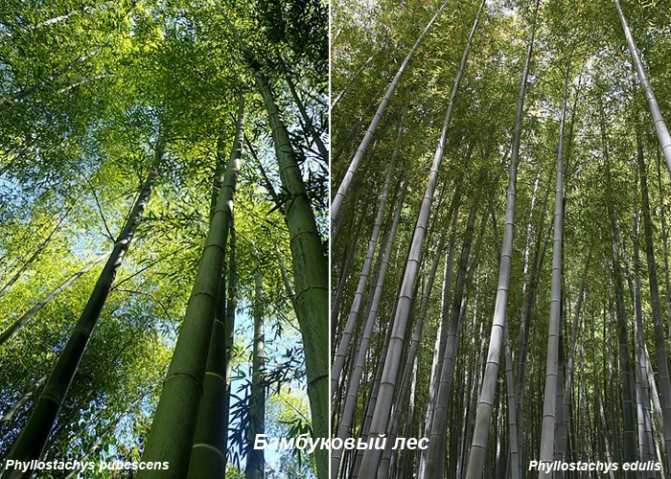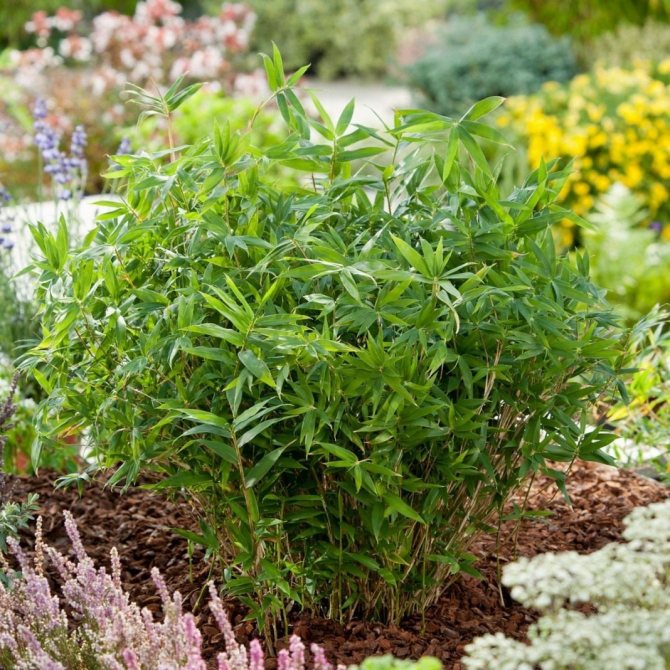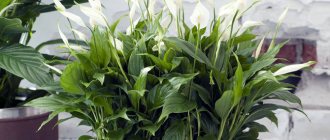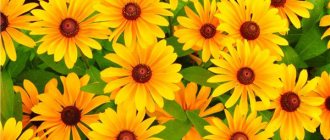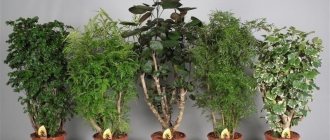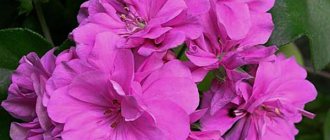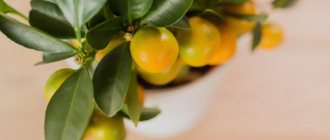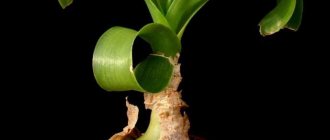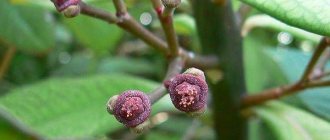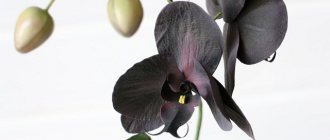Bamboo is a plant found in the Asian jungle as well as other tropical and subtropical regions. Bamboo can boast of unprecedented growth rates - for this, in the first place, it is famous.
Some types of bamboo can add up to half a meter per day. And under ideal conditions, madake bamboo grew by 120 cm per day.
Representatives of bamboo of the dendrocalamus species grow the longest, the stems of these plants add, on average, 40 cm per day.
The plant is useful: a lot of things and materials necessary for the household are made from bamboo, its young shoots are used for food. Let's take a closer look at a unique plant, find out what its features are, what are the varieties, find out how fast bamboo grows.
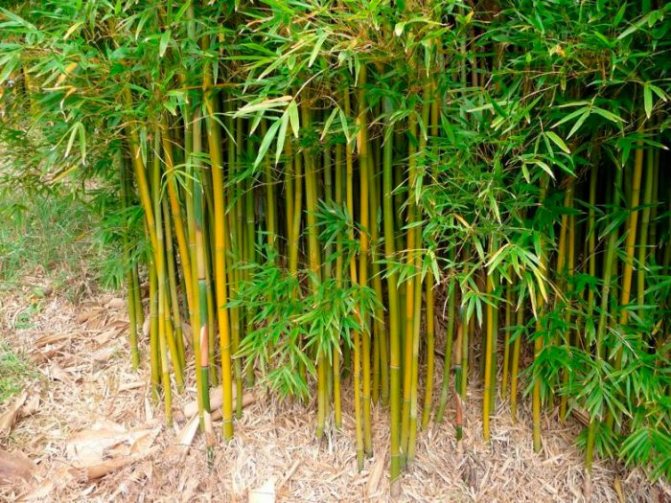
Description of the plant
Consider a more detailed description of Bamboo.
Homeland of growth
The homeland of bamboo is Australia, Asia and America. Tropical parts of these continents.
REFERENCE!
For growth, members of the family need warm weather and high humidity.
Stem
The stem of a bamboo is a cross between a stem of a tree and a grass. The height reaches forty meters. The crown is branched. Growth is happening at an incredible rate. At times it reaches a whole meter per day. Bamboo is one of the fastest growing plants in the world.
Escapes
Shoots are hard both inside and outside. The core is bright yellow, with the knees of the air chambers. If the bamboo is going to be eaten, then it is harvested after it rises.
In this case, the shoots should be very strong, surrounded by leaves, which must be removed before cooking.
Bamboo shoots contain a cyanogenic glycoside. Its properties cease after keeping bamboo at a high temperature, for example, in an oven.
Leaves and branches
The leaves are lanceolate. The petioles are incredibly short. Multi-flowered spikelets, singly or in large inflorescences, are attached to the branches. Bamboo branches bear only scale-like leaves. The rest of the leaves stick directly to the stem.
Root
The bamboo root is highly developed; is capable of spreading over a great distance in a short time. A large number of powerful stems also grow from the rhizome.
Fetus
Bamboo fruit forms only once in twenty-five years,
since bamboo blooms exactly once every twenty-five years. It blooms strongly and profusely, while covering vast territories. After flowering, bamboo shoots die off. Only the rhizomes are preserved.
Wintering and reproduction of pleioblastus
A low-growing multi-flowering plant is capable of wintering well under a snow cover in the middle lane. But since winters are often unstable, relying on natural insulation would be a big mistake: growing these, and any other winter-hardy bamboos, can thus turn into a lottery.
It is better to additionally create a dry shelter above the pleioblastus, which, even in snowless periods, will protect the bamboo from any frost. Natural frost resistance down to -28 ° C allows you to be content with a simple shelter. After the first frost, the plant is spud with dry foliage, and protected from above with spruce branches - that's all the measures that need to be taken. And during the winter, you can always add snow to the bushes, which you will distribute on the site.
When grown in a container culture, pleioblastus are harvested for the winter in frost-free rooms with good lighting. Winters well in warm and semi-warm greenhouses, greenhouses, cool rooms. With the onset of the first cold snap, the containers can be insulated in order to leave a beautiful plant in the garden for a longer time and remove it only after stable night frosts.


Cultivation of Pleioblastus in containers.
This type of low-growing bamboos is propagated exclusively by one vegetative method - by dividing the clumps. It is necessary to carry out the separation in the spring, when the soil is already well warmed up, and the plant shows signs of growth. It is better to separate large divisions in pleioblastus, leaving a sufficient number of shoots and powerful roots to accelerate adaptation. Small plots will require increased watering for a very long time.
Care
Bamboo is actually a very rare species of its kind. Indoor varieties can be more than a meter in height, but they can be cut to maintain the required height. Representatives of the species require constant scrupulous care, since in their structure they are quite specific.
REFERENCE!
Moderate temperature is preferred for keeping. When the heat is over 30 degrees, the leaves of the plant begin to dry out.
Bamboo is a flower that can withstand small freezing temperatures, but don't risk it, keep it warm.
Lighting
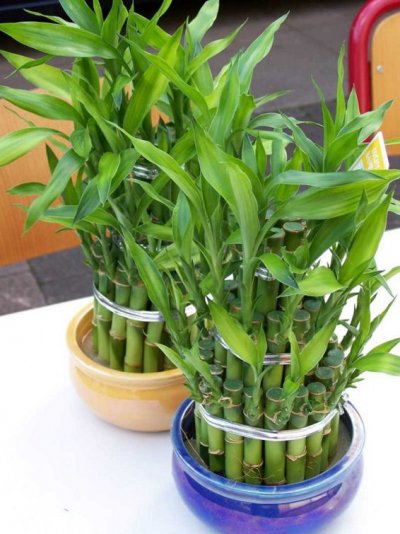

Any representative of flora and fauna needs light. Sunny or artificial. Bamboo also needs to be kept in a sunny place, but sometimes removed from there.
With its constant exposure to the sun, the leaves can burn out, dry out.
No, they will not die, but their appearance will definitely not please you.
In the summer, it is better to keep the plant outdoors, in a calm place.
A greenhouse or greenhouse is perfect.
Watering
In summer, it requires frequent watering, in winter it is more rare. The main thing is to prevent the earthen lump from becoming too dry.
But waterlogging should not be allowed either.
Keep the soil moist for an hour after watering, and keep it dry until the next watering.
IMPORTANT!
Since in nature bamboo grows in humid regions of the world, in room conditions it must be frequently and abundantly sprayed with warm water from a spray bottle. This should be done at least once a day.
Fertilizers
Bamboo is a plant that needs fertilization to enhance its natural strength. In the summer, it should be fertilized every two weeks,
since this is a period of growth. In winter, fertilize is not worth it at all. As fertilizer, use any sweep for indoor plants. You can buy it at any specialty store.
Young plants are transplanted strictly in the spring. Do it every two years.
The soil must be nutritious. Special purchased land is recommended as the plant's rhizomes are strong and need land that can supply them with the necessary nutrient levels.
The pot should be wide and high,
since a lot of land is needed. The bottom of the pot can be equipped with drainage.
You can learn more about caring for bamboo at home.
Conditions necessary for pleioblastus and their landing
It is an amazingly textural plant that works best with plants with no less expressive shapes and texture - ferns, decorative grasses with thin leaves, large-leaved and colorful badans, blooming astilbe like a floating cloud, cuffs, contrasting large-leaved hosts and other expressive perennials.
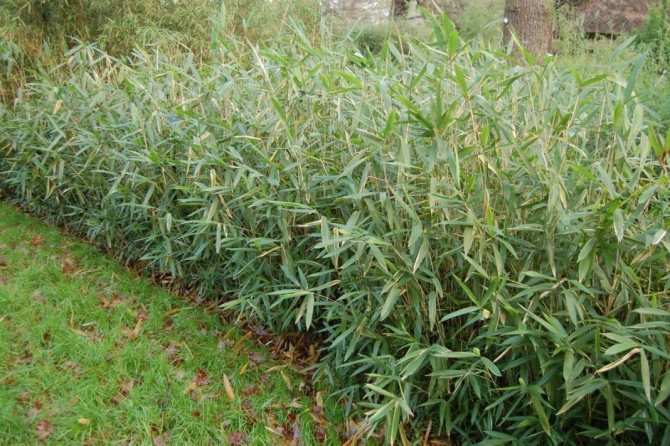

Pleioblastus silvery (Pleioblastus argenteostriatus). <>
Gorgeous bamboos are always in motion.And to emphasize their musical character, it is worth planting them in open areas (with the exception of cold winds and drafts), so that at least from one side the plant is open to a gentle breeze.
Pleioblastus is completely unpretentious to lighting and looks great both in sunny places and in diffused lighting or in partial shade. Most often, pleioblastus are planted precisely in shading - there are not so many plants with such a bright play of colors, light and texture effects. And in the company of other favorites of semi-shady, secluded areas, the pleioblastus literally shines.
But the choice of soil should be taken into account more carefully. Like almost all bamboos, Pleioblastus is able to grow in lean, dry, depleted soil. But in regions with severe winters, the plant for good development and rooting needs to be provided with more fertile and high-quality soil types - worked out, with organic and mineral fertilizers applied. It is best to choose abundantly moist soils, places near water bodies. When choosing dry soil, keep in mind that you will need to water the plant more often.
Planting pleioblastus is not that easy. But the point is not in the technique itself, but in the fact that, as with all bamboos, measures will have to be taken to limit the area of growth. Of course, there is no such problem in containers, but a possible growth zone in open soil should be immediately separated by a screen - shields, borders, dug to a depth of about 20 cm.After planting, pleioblastus for a very long time - until active growth resumes - should be watered regularly, maintaining high humidity soil.
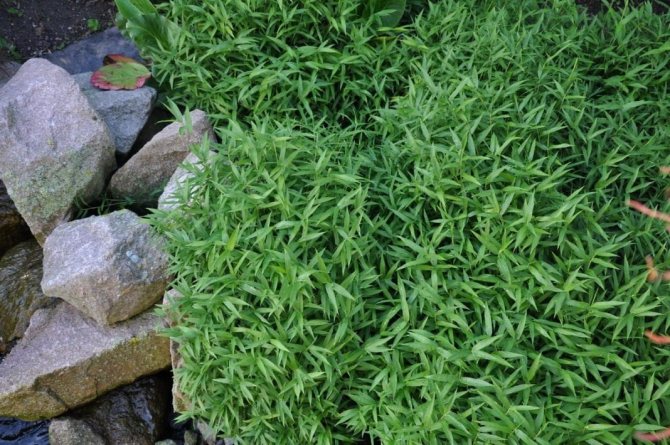

Pleioblastus
Diseases and pests


There are many reasons why your plant suddenly starts to deteriorate and turn yellow. In order to prevent this from happening, you should follow the care instructions exactly, since the cause of the disease may even be bad water or soil poorly flavored with mineral salts and fertilizers.
Fungi and a variety of infections are often the culprits. Moreover, not only the leaves turn yellow, but also the bamboo trunk.
Leaves that have suddenly turned yellow should be cut off.
Places on the stem where the infected leaf was - carefully cut and disinfected. Charcoal is suitable for the role of a disinfectant, with which you should slowly lubricate the damaged section of the stem. After the disinfection procedure, the place can be lubricated with wax.
Indoor bamboo copes well with many sores. But you still need to know the symptoms. Learn the main diseases of indoor plants in order to save the life of the plant in time.
Spider mites
Are the most common pests affecting this plant. Wash the flower with soap and water, after which it should recover. If you want your home bamboo to be in good shape all the time, then make its living conditions as organic as in nature, where the plant lives. So it will feel at ease. After all, nature is nature. She will take her own anyway.
You need to observe the organic nature of all factors: temperature, humidity, amount of minerals, etc.
If you do everything the way the plant needs, then your decorative bamboo will be an excellent addition to the interior and will stand for many years, serving faithfully. If not, then within a year the plant will simply die.
You can learn more about common diseases and pests of bamboo.
Reed bamboo has been used by man since ancient times.
The plant has been widely used in folk medicine. With his help, they decorated the interiors of homes and gardens. The healing properties of bamboo have also taken place in the use of it by people. On the basis of bamboo, medicines are made that treat many diseases. Bamboo is a great decoration, but it requires careful maintenance.
Types of decorative garden bamboo
At the moment, there are about 1 thousand plant species.
They can be conditionally divided into:
- grassy low;
- straight-stemmed with a stiff stem.
It should be noted, however, that different varieties like different conditions. So, in Europe, Fortune bamboo is actively used. It has variegated leaves and a graceful stem. The plant needs careful care.
There are also frost-resistant varieties, for example, Shibataea kumasaca. The presented option looks great in pots. It doesn't grow very much.
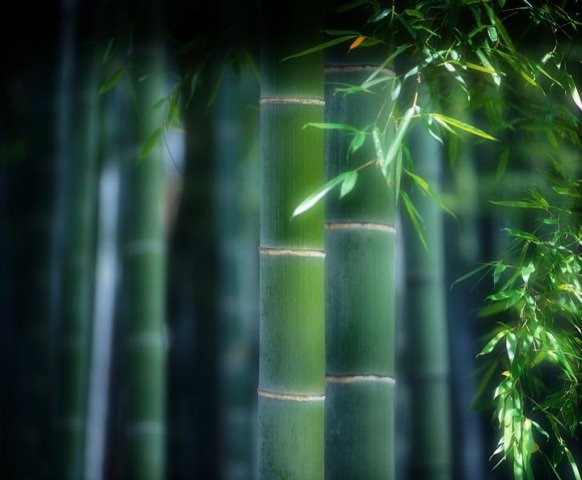

What is it
Bamboo is a plant that in appearance resembles both tall grass and a tree. It has a straight stem and wedge-shaped leaves. This oriental cereal combines calm, soothing colors - yellow and green. There are many types of it. The plant is found not only in the wild. It is actively used by people in landscape design, decorative gardening, for the production of furniture, interior items and even in cooking.
The stem has a fibrous structure. Roots and rhizomes are located horizontally underground. Buds are formed on the rhizome, which gradually turn into sprouts. Most bamboo species bloom once every sixty or one hundred and twenty years. The plant reproduces quickly - through rhizomes or seeds. In the latter case, this happens quite rarely. The stalk of the bamboo is very strong, shoots with leaves grow from it. In places where the shoots emerge, thickenings are formed on the trunk. They are called nodes, and the part of the stem between them is called internodes.
Low-growing bamboo with bright foliage
Along with sazas, forgesia and leaf graters, pleioblastus, or whatever they can call them, elliptic suitable for growing not only in the southern regions. Pleioblastus may not have the highest frost resistance, but subject to the correct choice of plants, purchases not in foreign catalogs, but varieties and seedlings already adapted to a specific climate with a declared high frost resistance, they will only present pleasant surprises in the middle lane.
Pleioblastus (Pleioblastus) - low-growing bamboos with a maximum height of about 50-60 cm in regions with severe winters.In nature and in warm regions, there are also higher, meter-long and larger multi-flowering plants, but the short stature allows initially not the most winter-hardy plants to cope well with more severe conditions ... Shoots of this bamboo forms very dense, turfy, seemingly continuous thickets, constantly expanding in breadth. Internodes up to 45 cm long emphasize protruding, embossed nodes.
The length of typical "bamboo" lanceolate leaves is from 8 to 30 cm. They are densely located on the shoots, often under the foliage of the twigs are not visible at all. Depending on the species, the color of this bamboo varies from the classic bright green to golden, gray, grayish, variegated with various cream or yellow stripes.
Multinetics represent Japanese and Chinese endemics of the family Zlakovykh (Poaceae), subfamily Bamboo (Bambusoideae). The Pleioblastus genus includes about 20 species of bamboos, and almost all natural species are considered as ornamental plants, all of them introduced into culture. True, only 4 species can boast of winter hardiness, sufficient for growing not only in zones 8-12, but also in the middle lane.
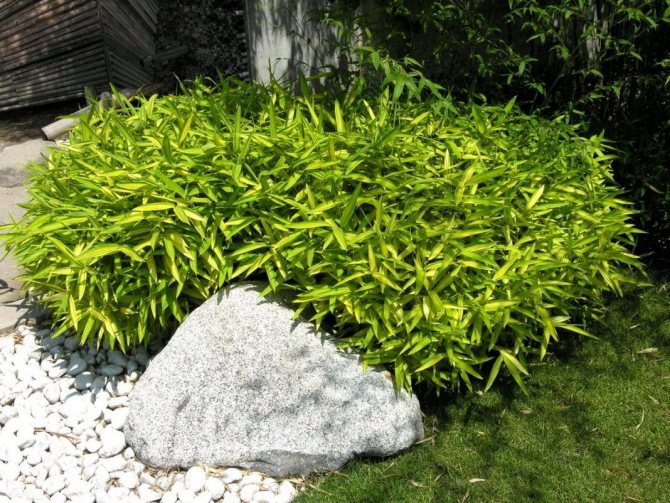

Pleioblastus green-striped (Pleioblastus viridistriatus).
What does it look like
Bamboo grows only in high humidity and warm climates. It is the climatic conditions that determine its appearance and active growth. The stem of this plant resembles grass and the trunk of a tree. The bamboo is very tall with a ramified crown. The shoots of the plant are hard inside and outside. In the middle of the trunk, the bamboo is bright yellow with hollow areas.
The leaves of the cereal are lanceolate, with short petioles. Spikelets with large inflorescences are attached to the branches. On the branches there are scaly bamboo leaves. The root is well developed. It is capable of expanding over long distances.The rhizome produces many powerful stems. The fruit of bamboo is formed only once every several decades due to the rare but abundant flowering.
How fast it grows
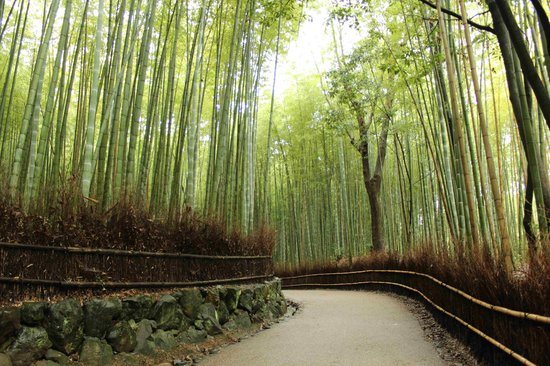

Many have heard about the incredibly high growth rate of this plant. Let us confirm this fact and clarify that in nature bamboo is the fastest growing botanical species. However, the growth rate of individual plant species and varieties can vary greatly. First of all, the growth rate depends on how developed the rhizome of the plant is. When the root is just gaining strength, the aerial part does not grow quickly.
Some varieties can add up to half a meter per day. And under laboratory conditions, madake bamboo from Japan grew by 120 cm per day.
Bamboo thickets are an unforgettable sight. Representatives of the dendrocalamus species grow the longest. The stems of these plants add, on average, 40 cm per day. Thickets occupy vast territories - real bamboo cities.
It is interesting that if you watch the bamboo continuously for several hours, you can personally see how it grows. No other plant on the planet can provide such a spectacle.
Shoots appear from the ground quite miniature, but the older they become, the faster they grow. After five years, the plant usually reaches a medium size.
The cycle of its development is interesting:
- A young plant grows slowly, because its underground, root part must first develop.
- Then comes a long stage of rapid, unrestrained growth, the formation of numerous lateral branches, shoots. How long this period lasts depends on the type of plant, usually it is several decades.
- Then comes flowering - specimens sprouted at the same time and bloom at the same time. Usually, flowering is recorded in the 20-30th year of the plant's life.
- Growth stops, the plant gradually dies off.
But only the green, aerial part dies off, the rhizome remains alive. If you do not allow bamboo to bloom, regularly cutting it off, you can significantly extend its life: it begins to die off after flowering.
Habitat
Bamboo. Where does it grow, what climatic conditions are comfortable for this culture? The tropics are considered to be the birthplace of bamboo. It can be found in Australia, America, Asia. It is thermophilic, it is badly affected by frost and cold wind. Some species also feel comfortable in the cold. However, the northern and temperate climates are not very suitable for the grain, as well as the intense heat. Frost-resistant varieties of culture are unpretentious. Their rhizomes develop in any soil. The plant takes root in Russia, but only as an indoor inhabitant.
Bamboo is evergreen. The life cycle is long. Poorly tolerates extreme heat, cold and drought. Able to survive in all conditions with proper care.
The use of pleioblastus in ornamental gardening
Like all bamboos, the pleioblastus constantly makes sounds, rustling, tapping, which in the garden seem to be a full-fledged wind chime. This plant literally revives any garden, transforms it. But noise is not the only benefit of this gorgeous low bamboo.
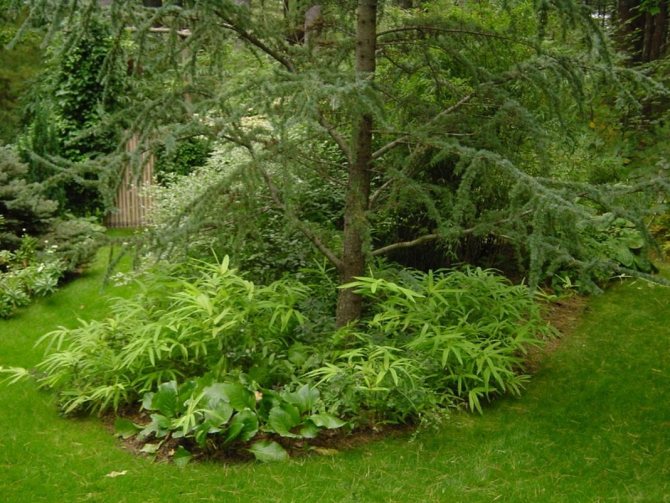

Pleioblastus in composition
In the design of the garden, multi-flowering plants are used as:
- oriental accent;
- excellent textured grain;
- one of the most variegated decorative leafy accents;
- in landscape style, natural plantings and massifs;
- for a spectacular design of recreation areas and in flower beds by the terrace;
- in the rock garden and meditation corners;
- in rockeries and rock gardens;
- as a major solo tub and pot soloist;
- as a style-forming accent;
- against the background of a lawn or a meadow of ground cover;
- for decorating ponds and dry streams;
- as a textured background;
- for lush, textured curbs and lawn framing.
Views
Is bamboo a grass or a tree? It is considered to be a plant or giant grass. There are about a thousand varieties of bamboo in the world.They all differ in height, stem width. Some species are similar to bushes. Absolutely all of them eventually adapt to new living conditions. One of the most popular types is the "bamboo of happiness". It is a small houseplant that grows in soil or water. It cannot be called a direct relative of culture.
The plant requires careful care, does not tolerate cold weather. Bamboo does not like clayey, waterlogged soil. Consider this if you want to grow a culture at home. If the culture grows at home in a pot, it is important to provide it with moderate humidity, warmth, but keep it away from the heating system. It is recommended to wipe the stem and leaves with a damp cloth.
Mystical meaning
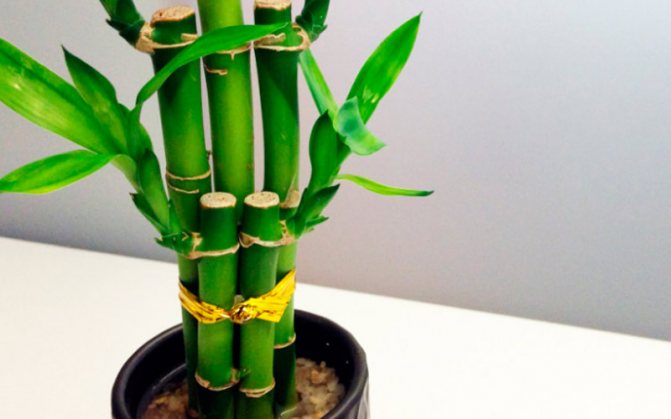

Bamboo shoots can even pierce a stone during a period of rapid growth. Thanks to this feature, in the east, bamboo is a real symbol of vital energy: indomitable and freedom-loving.
Miniature bamboo varieties are also grown at home. Keeping bamboo in your home leads to happiness, prosperity and health: this is what Feng Shui experts believe.
In general, according to Feng Shui, bamboo simultaneously symbolizes eternal love, and good luck, and loyal, long-term relationships. In the east, bamboo is also prized as a symbol of productive longevity, consistency, beauty and grace. It is also believed that bamboo helps to find peace of mind, to find spiritual truths. In Taoist and Buddhist religious teachings, bamboo is a sacred plant.
Features of the
What are the characteristics of bamboo? Where does it grow and why is it able to quickly adapt to different climatic conditions? The most interesting and, perhaps, the main type of bamboo grows in the East Indies. Its trunk is twenty-five meters high and thirty centimeters in diameter. The structural features of bamboo make it possible to use it in construction. In addition, the old stems of the plant give off a liquid with a sweetish taste, which is used to make polishes and porcelain. Features include rapid growth, massiveness, and plant properties. Young crops are eaten, the stem is used in the interior, household, industry, including textiles.
Available exotic or bamboo at their summer cottage
For centuries, bamboo has been a highly sought after and popular plant. And this is not surprising at all, because the plant has a number of unique features and is quite common.
This plant is extremely strong, but at the same time very light plant, which has no analogues in terms of speed and speed of development and growth. Bamboo is used in a wide variety of industries, kitchen and household utensils, furniture, building structures are made from it, and when special processing is carried out, fibers are obtained from bamboo and fabric is made, it is also successfully used in cooking. It is also a very cute and cute plant from the multifaceted family of cereals, which fits perfectly into a variety of landscape compositions and pleases the eye.


In landscaping, bamboo is successfully used in a variety of landscape and decorative-aesthetic designs for parks and gardens around the globe. True, except for regions with too cold or too arid climate. And although the majority believes that it is cultivated exclusively in the Far East and Southeast Asia, this does not at all constitute an obstacle to its cultivation in our latitudes, because this plant grows in its wild forms on the territory of Sakhalin and the Kuril Islands.
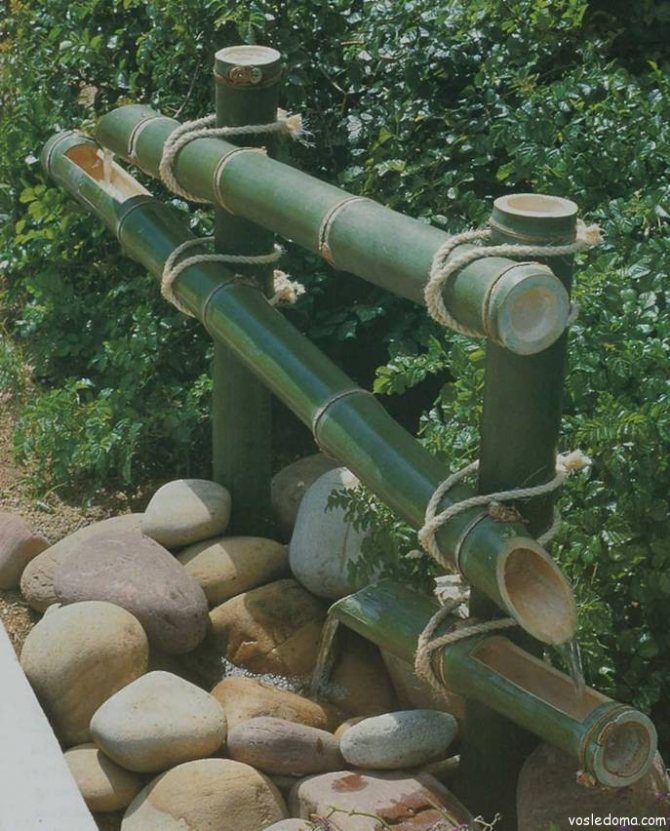

True, it should be noted that for the use of bamboo in hedges and walls, or other elements of landscape improvement, you need to understand some points. Namely:
- In nature, there are more than a thousand varieties of this plant (they are divided into two large groups: herbaceous low and rigid-stemmed straight-stemmed) and not every species easily and quickly adapts to completely new growing conditions. As a result, when choosing one or another species or variety of a plant, be guided not only by its external data, but also by the plant's ability to adapt. Today in Europe, for example, variations of Japanese bamboo with bright and colorful leaves are quite common; these plants grow relatively short and have gracefully beautiful stems. The most common species is Bambusa fortune, which can also be called Fortune bamboo, Pleioblastus variegates, Sasa variegate, Arundinaria variegate, Bambusa variegate, Arundinaria fortune.
- This species, during the period of its most intensive development and growth, and this, as a rule, a month and a half, is able to stretch up to 50 centimeters per day, while forming a wonderful appearance. But during this period of time, he needs regular and abundant soil moistening and fertilizing with nitrogen-containing fertilizers.
- Most varieties of bamboo are distinguished by a very high growth rate and rapid "capture" of fairly large land areas. Based on these features and the fact that bamboo reproduces mainly in a vegetative way, it is recommended to plant it in special containers, or to enclose the place of the planted groups in the ground with plastic plates buried in the soil, which will be impervious to the root system. It is necessary to bury such plates to a depth of 60 - 70 centimeters. Also, bamboo grows well and develops in large pots.


Also, do not forget that at the initial stages, the plant requires reliable and careful protection from weeds and cold weather. Of course, there are many frost-resistant varieties that also have excellent aesthetic data. An example of such varieties is Shibataea kumasaca, which is also known under the following names: Bambusa aureostriata, Phyllostachys ruscifolia, Sasa aureostriata, Bambusa ruscifolia, Bambusa kumasaca. The peculiarity of this species is the convenience for growing in pots and the absence of a tendency to overgrowth.- When growing Shibataea kumasaca on your plot, it is worth remembering to regularly thin out and prune. It will also be interesting that the cut stems can be used for a wide variety of household needs, for decorating a house and a plot, for example. To do this, it must be dried while hanging.


Summing up, I would like to note that the plant blooms extremely rarely, approximately 1 time in 25, or even 60 years! At the same time, the entire planting blooms as a whole, and immediately after the flowering period, all plants die. But do not be very upset about this, because usually plants leave a sufficient number of young shoots that are able to create a new population that can easily revive a tropical oasis, and if you take into account the growth rate of this plant, this will happen very quickly.
Affordable exotic or bamboo at their summer cottage | Near the Househttps: //bgn.imadeself.com/wp-content/uploads/2013/12/1_16-450Ч300.jpg https://bgn.imadeself.com/wp-content/uploads/2013/12/1_16-450Ч300- 150 × 150.jpg2014-02-10T20: 49: 41 + 03: 00 Near the HouseDesign with your own handsBamboo, summer cottageBamboo has been an extremely demanded and popular plant for many centuries in a row. And this is not surprising at all, because the plant has a number of unique features and is quite common. This plant is extremely strong, but at the same time very light plant, which has no analogues in terms of speed and speed of development and growth. Bamboo is used in ... Near the House Near the House


Other Posts Related:
Areas of use
Where is bamboo used? Where does this culture grow and what does it mean for the economy? The use of cereals is huge. Houses are built from the bases of the trunks of large species, and musical instruments are made. Bamboo is highly regarded in the textile industry. Bamboo fiber is used to sew clothes, linen, blinds, wallpapers, carpets, blankets, pillows and much more. The bamboo filament material has amazing properties.It is excellent at absorbing moisture, hypoallergenic, antibacterial and very soft. In addition, things made from it are durable, practical, beautiful.
Today bamboo is actively used in interior design. Decorative partitions, furniture, accessories are made of it. He brings naturalness, environmental friendliness, naturalness into the room. In countries with a warm climate, strong dwellings are built from the culture, and the shoots of young plants are eaten. The popularity of bamboo is due to its resistance to climate change and mechanical stress. Bamboo is also used to make thick silk paper and tableware.
How is it used
Bamboo is widely used in industry. Shoots and other parts of the plant are used in the following industries:
- medicine;
- furniture manufacturing;
- cooking;
- landscape design;
- building;
- textile industry;
- making small household items, tools.
In ancient times, Japanese samurai made their bows not knowing a mistake from bamboo. And in the modern world, the best professional bows are made from this plant.
In Japan, such a dish as nuka is popular: it means young shoots cooked together with rice flour. Also in this country they eat the seeds of the plant - outwardly they very much resemble our oats.
And in China, in ancient times, calligraphy brushes and fireworks were made from the stems. They wrote on plates from an adult large plant, as well as on paper made from bamboo cellulose.
The fiber has wonderful moisture-absorbing properties, it is distinguished by its unique softness: it is these properties that make it possible to use it as a raw material for making clothes, stuffing pillows, blankets.
Suitable plant age
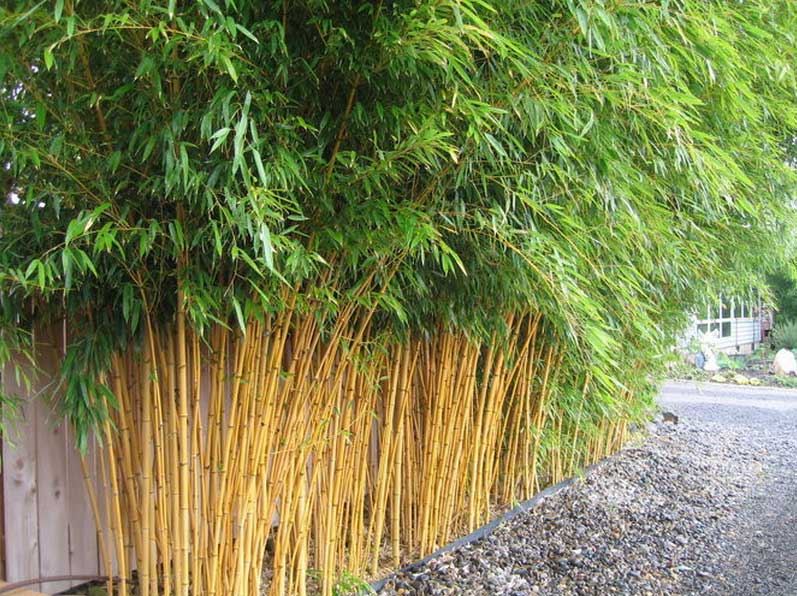

For industrial purposes, stems older than one year of age are suitable. Young bamboo is filled with water and is therefore only used in cooking. The best and highest quality raw materials for the manufacture of various items are considered to be stems aged from three to seven years. It is this raw material that is used for the manufacture of textiles, soft towels, bathrobes, wallpaper.
When bamboo reaches the age of seven, its stems are used for cellulose to make blankets, mattresses and pillows. And the hardest wood goes into the production of stylish blinds.
Growth rate
The fastest growing plant in the world is bamboo. A photo of this cereal demonstrates how it looks and how high it reaches. Young bamboo can increase in length by ten centimeters per day. Some species of this culture grow by fifty centimeters in 24 hours! The main difference between bamboo and a tree is that the former grows to its final height in a season, and the latter takes years to do this. The reason for the high growth rate lies in internodes. They simultaneously stretch, increasing in size. However, the growth rate is uneven and decreases from the root to the top. During the growth period, the plant not only grows upward. Its stem thickens and the nodes become larger. There is evidence that a grandmother can stretch one meter in just a day!
Once the sea argued with the sky about which of them is the most powerful. The sea sprayed the sky with its foam. The sky covered the sea with earth and stones. So the first islands appeared, and on one of them the first tall plant grew, with many leaves, but without branches - the first on earth. Then a man appeared from him and that became the beginning of all mankind.
Bamboo means so much to Asian countries that it even explains the creation of the first people.
This is the story of one Filipino. It shows what role bamboo plays at all times. This is a very amazing plant. Tall and at the same time not a tree. It looks not very durable, but it can withstand strong gusts of wind. They dedicated poems to him, painted pictures, composed songs.
Types of pleioblastus for cultivation in the middle lane
Suitable for growing in soil in regions with harsh winters, species of a multicolored plant, which can winter without shelter in zone 5, and with shelter - endure temperatures below -28 degrees, include:
- Playoblastus Simone (Pleioblastus simonii) is the most popular species of multi-flowering plants, which in regions with severe winters is limited to half a meter in height, and at home it can grow to more than 6 m.The shoots of this bamboo increase in diameter with age, are straight, strongly branching, differ in elongated internodes, massive nodes and lanceolate, long leaves - from 8 cm to more than 20 cm. This pleioblastus forms very dense sod, its densely leafy stems are incomparably elegant. The basic plant is rare, but one of the forms of the plant has already become legendary in our country. The inimitable shape of variegatum is a bright green bamboo with longitudinal creamy stripes on its leaves.
- Playoblastus green-striped (Pleioblastus viridistriatus), we like to call it Playoblastus golden-striped (Pleioblastus auricomus) is a compact and sprawling bamboo about 70 cm high, famous for its narrow tubes of stems with a purple color and a basic yellow color of the leaves, on which longitudinal dark green stripes stand out brightly.
- Playoblastus Fortune (Pleioblastus fortunei) is a small-leaved, low bamboo that rarely rises even to a height of 50 cm and seems almost like a ground cover. The brightly saturated color of the base plant is not as popular as the variegata form, decorated with thin longitudinal stripes of almost white color.
- Pleioblastus silvery (Pleioblastus argenteostriatus, formerly known as pleioblastus shino - Pleioblastus chino) - a seemingly gray-silver species with a muted shade of green and longitudinal whitish stripes, looking like metal clumps from a distance. Very graceful, dense, openwork bamboo that highlights the compositions. A fairly low appearance, as a rule, less than Simon's pleioblastus. The shoots are narrow, with a purple bloom, changing to a white waxy tint under the nodes.
For growing in tubs with shelter for the winter, experimenting with more original species or for southern regions, you should pay attention to one more type of elliptic plants - pleioblastus cereal (Pleioblastus gramineus), with the declared 7th zone of frost resistance. This is a thin-stemmed bamboo, in which even very old shoots will not exceed 1 cm in diameter, and the leaves are especially thin and graceful. From a distance it seems almost weightless despite the dense turf.
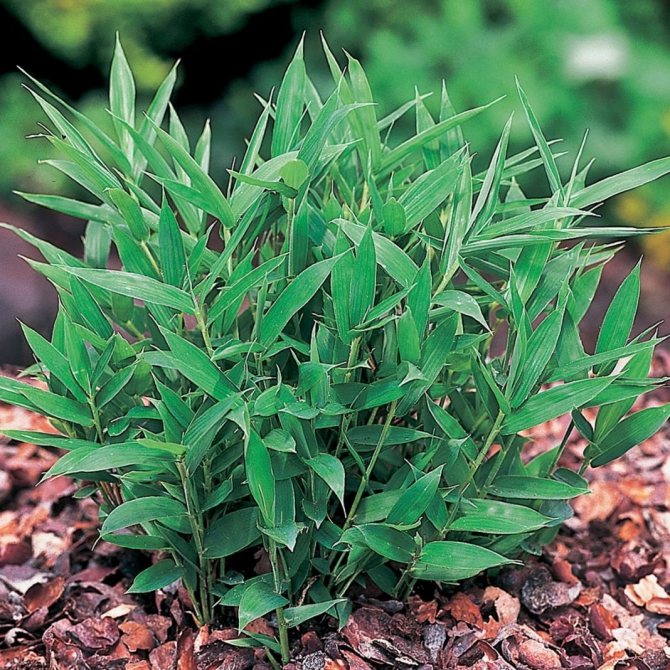

Simon's Pleioblastus (Pleioblastus simonii). <>
Strategies for growing pleioblastus in the middle lane
- shelter for the winter with dry hilling;
- growing in tubs with cool wintering and displaying in the composition as a permutation plant;
- growing as a potted plant to decorate grounds, terraces, balconies.
Improper use
Such a high-speed property of the plant was used both for the benefit and harm of humans. People generally try to adapt all the best to kill as many of their own kind as possible. And the bamboo found a peculiar one.
The property of bamboo to grow rapidly was used in order to execute people or torture them in a sophisticated way until their death.
In China, the following method of execution was used, based on the property of plants to germinate quickly. They took the sentenced to death and tied a young bamboo over the bed. Previously, the tops of the plants were given a pointed appearance, so that a kind of stakes were obtained.
What happened next was like an extremely sophisticated torture. During the day, the plant increased in growth by tens of centimeters, piercing the skin of the executed in several places. The sprouts dug into his body, germinated inside the abdominal cavity and caused severe torment.
According to eyewitnesses, recorded by chroniclers, a person could die like this for hours, or one of the executioners "helped" him to go to the next world faster with the help of a beheading or poison.
Propagation of bamboo
If you decide to start breeding bamboo, you need to familiarize yourself with how it happens. In fact, reproduction is not difficult.
- In the spring, they dig up 4 stalks of bamboo, which has already reached 3 years of age.
- He transplants to the place on the site where there is partial shade.In this case, the depth should be familiar to the plant.
- Abundant watering is carried out.
- 1/3 of the top of the shoots is cut off and planted in the soil.
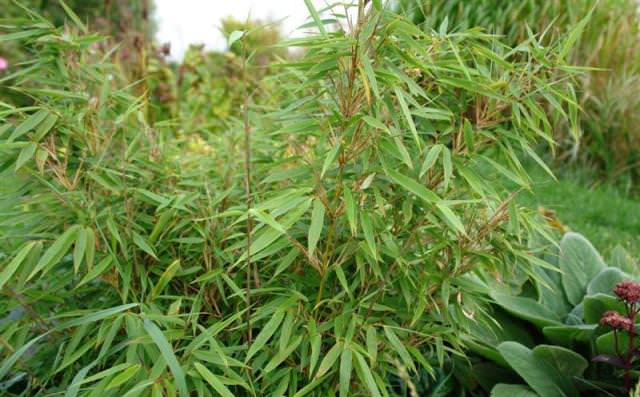

Botanical description
Bamboo grows in tropical climates. In nature, it settles on the banks of reservoirs, on the sunny edges of tropical forests, loves felling. The plant is used for industrial purposes, for decorating flower beds and apartments.
The tallest variety grows in India is Burmese bamboo. Its stems are tree-like, up to 20 cm thick, grows up to 40 m high. Exceptionally low-growing, miniature species are used as pot crops.
As a houseplant, bamboo is prized for its thin, straight stems with delicate, translucent greens. It looks good in compositions with plants that have large leaves. Indoor bamboo blooms very rarely: small flowers in panicles, like all cereals. Its leaves are lanceolate or linear, petioles are short. Refers to monocarpic crops - dies after flowering. It is unpretentious in cultivation, but has not received wide distribution.
Useful properties of bamboo
Young bamboo shoots are not only delicious but also rich in nutrients. They are among the top 5 healthiest foods in the world.
The main properties of bamboo were recorded in an ancient pharmaceutical text from the Ming Dynasty (1368-1644): "It is cool, sweet, non-toxic, quenches thirst, improves circulation, adds Chi and can be used daily."
In Asian countries, the anti-inflammatory and restorative properties of bamboo, due to the presence of a strong antiseptic in its fibers, are often used for colds and SARS, as well as for allergies and asthma.
Bamboo is also one of the few plants with a high amount of silicic acid, which:
- Helps strengthen hair and nails;
- Has a beneficial effect on the skin;
- Has a calming effect in depressive conditions.
Bamboo is effective for peptic ulcers, digestive disorders and diarrhea. In Asian countries, it is also used to treat diseases such as jaundice, tuberculosis, fever, and dysentery.
Bamboo extract strengthens the walls of blood vessels, improves blood supply to tissues, reduces capillary permeability and increases their elasticity and tone.
For medicinal purposes, not only bamboo shoots are used, but also other parts of this amazing plant:
- Bamboo roots are used as a general tonic;
- Bamboo leaves, which have antipyretic and expectorant properties, are considered a good cough medicine;
- Bamboo juice is used as a remedy for apoplexy and epilepsy.
Breeding features
Indoor bamboo can only be propagated by seeds or by dividing the bush during transplantation. Cuttings are not applied. It is impossible to get seeds from your plant - only store-bought planting material is used. Let's take a closer look at both methods.
- By dividing the bush. During transplantation, the roots are shaken off the ground, the bush is cut into several parts with a sharp knife. Each part should have several stems and a full-fledged root system. Places of cuts are powdered with charcoal powder. Delenki are planted in pots slightly larger than the root system. The first week is watered moderately, trying not to overmoisten the soil in order to avoid decay. It is not recommended to divide the bush in hot weather. The optimal time for transplanting and dividing is early spring.
- Seeds. Growing from seeds is a rather complicated process. Before sowing, the seeds are alternately soaked, first in a solution of potassium permanganate, then in a growth stimulator. Sow in flat bowls with loose, fertile soil, cover with foil. They are placed in a warm, bright place. The first shoots may appear only after three months. All this time, the greenhouse is ventilated, the moisture content of the substrate is maintained. Faster results can be achieved by germinating seeds in a hydrogel.
Conditions for keeping bamboo
Light is a very important factor in keeping such an exotic plant. He must be absent-minded. Otherwise, the foliage begins to lose color, turn yellow and the plant completely loses its attractiveness.
Under natural conditions, the growth rate of bamboo per day can reach 20 cm. At home, of course, it does not grow at such a rate. But it reaches impressive sizes pretty quickly with the right ratio of light and moisture.
It is useful for the plant to carry out water procedures and pamper it with a shower. Bamboo loves it very much.
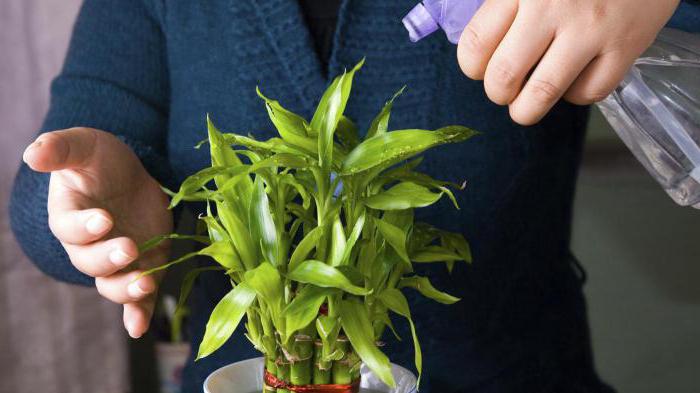

Periodically, you need to wipe the leaves with a damp cloth.
Every exotic plant owner is interested in the growth rate of bamboo. The rules of planting and caring for the plant will ensure its intensity.
Bamboo is not picky about the soil, but it is better to purchase a special soil for the Dracaena family. The small plant should be transplanted annually in the spring. If the plant is adult, transplanting should be carried out no more than once every 2-3 years.
The growth rate of bamboo and the planting rules are closely interrelated. If you ignore the basic rules, the plant will develop very slowly.
It is important to choose the right bamboo pot:
- it should be wide and voluminous;
- the distance from the roots to the walls of the pot should not be less than 5 cm;
- there should be holes at the bottom.
Besides the pot and soil, drainage is important. It must be present at the bottom of the pot without fail. The optimal drainage layer is 3 cm.
In order for the plant to form correctly and the growth rate of the bamboo to increase, you need to periodically prune.
The pruning procedure is carried out with garden shears or pruning shears. The plant is pruned at the request of the owner. Sections are processed with wax.
But the cut stems are used to propagate bamboo. If the plant is inactively shoots, then you just need to pin the top edge. After that, new shoots will go on the sides.
Features of home bamboo
An amazing feature of homemade bamboo is the ability to grow the plant both in soil and in water.


With this extravagant type of growing flower crops, it is important to change the water in the vase at least once a week and monitor its level. Water for growing bamboo must be of high quality.
When planting bamboo in water, you should pay attention to the length of the roots. Too long parts are trimmed. The roots are fixed in a glass container with decorative stones.
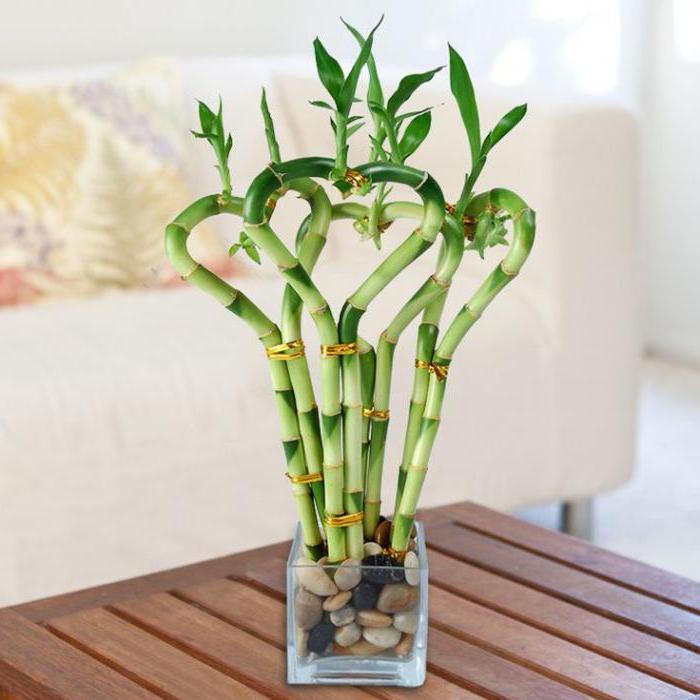

When choosing vases, it is better to give preference to transparent ones, since you can always easily control the amount and quality of water.
With water cultivation, the growth rate of bamboo and the saturation of flowers increase, since it is this type of plant that most values water.
Another unusual property of bamboo is its rare flowering. The plant blooms once in a lifetime, namely at 30 years old. Unfortunately, after the flowers fall off, the plant dies.
What types are suitable for an apartment
Low-growing types of bamboo look spectacular and elegant. The most common are four varieties.
- Shiny bamboo (sasa nitida). Tall purple stems reach three meters in height. Grown in tubs, often as a greenhouse plant.
- Multilayer bamboo (bambusa multiplex). One of the tallest indoor varieties - it grows up to four meters. The height is adjusted by cutting the growth point.
- Glaucous bamboo (bambusa glaucescens). The original miniature variety, no higher than half a meter. Looks good on its own and as part of compositions.
- Arundinaria is variegated. Arundinaria refers to reeds. Outwardly, it is very similar to the bamboo of the dwarf varieties. Leaves are variegated, with whitish or cream stripes. The maximum height is 1 m.
Photo
See further photo of bamboo:
Mass production and small business
In some countries, mainly in China, bamboo is used for mass production of furniture, clothing, kitchen and household accessories, and other consumer goods. They can be found more and more often in Russian stores.
Some Russian garment factories buy large quantities of bamboo yarn from China and produce bedding and clothing.
In addition to large-scale production in third world countries, many small firms are involved in the bamboo industry. They produce various souvenirs, furniture, small lightweight building structures, clothing, etc.
Where does bamboo grow
The area of distribution of bamboo is vast, it covers the subtropics and tropics, but it can be found here and there in the temperate zone. In North Africa, the dry air of the Sahara spreads far away, so the growing area has shifted to the south of the continent. The eastern part of Asia is overgrown with a plant that has a tremendous growth rate, almost everywhere.
In the photo you can admire the graceful trunks and leaves of a tall plant grown in the southern part of Sakhalin Island. Occurs on the southern islands of the Kuril ridge. Farmers in temperate latitudes began cultivating the giant cereal in the 19th century, and in the territories of Chile and Argentina, the boundary of bamboo cultivation extends to 47 degrees South latitude.
Description
If we take the entire bamboo subfamily (Bambusoideae), then it already has more than 1100 species. The entire subfamily belongs to the Poaceae family. Among other things, bamboos can be divided into two main types (tribes):
- The tribe of bamboos (Bambuseae) are plants familiar to our presentation with lignified tall stems and beautiful crowns.
- Tribe Olyreae (Olyreae) - these include plants growing like "ordinary grass", thickets. As a rule, representatives of this tribe are small in height and non-woody.
Bamboo is the fastest growing plant on Earth. The growth rate of some species is striking - up to 75 cm per day (according to some reports, one of the representatives of Phyllostachys bambusoides “set” a growth record of 120 cm / day).
In ancient times in China, the plant, because of this characteristic of its growth, was used as a weapon of execution, when young bamboo shoots were planted under a tied person.
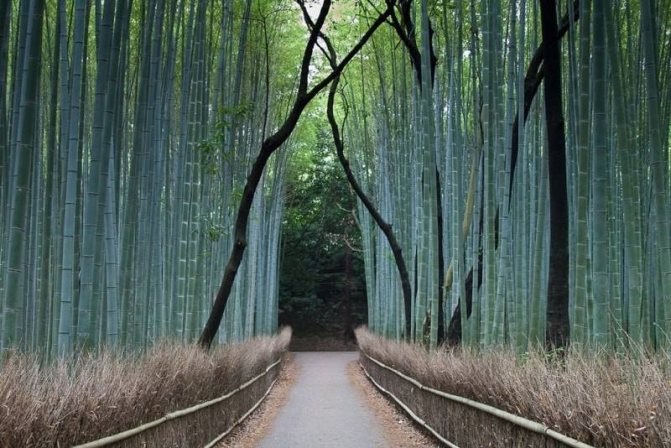

The height of mature lignified stems can reach incredible sizes - up to 35-40 meters and a stem girth of up to 80 centimeters (Dendrocalamus brandisii). Leaves are lanceolate, herbaceous with small roots. Bamboo blooms once in its entire life, after which either the entire plant or only the ground part dies off, in the second case, the rhizomes remain and are a substrate or growth points for young animals. But, as a rule, flowering leads to the fact that the plant simply disappears from its usual territory. The beginning of the flowering of bamboo is still a mystery, and the very process that causes this state is not clear. As one of the measures when cultivating this cereal, limit the chance of unexpected flowering by pruning. Inflorescences are often panicle, large. Flowers are bisexual, wind-pollinated.
The rhizome of the plant is developed, with a horizontal arrangement in the ground on which buds are formed - future sprouts.


The roots of bamboo grow quickly, and easily, in the process of growth, can take over huge areas, therefore, in the process of cultivation, it is necessary to create fences that prevent them from creeping underground.
Problems with growing ornamental bamboo
Despite the fact that this plant is quite unpretentious, with improper care, various problems can arise:
- The growth rate of bamboo may be too slow. It is necessary to provide the plant with feeding.
- The leaves have lost their brightness or turned yellow. This change is a consequence of a lack of moisture and sunlight. If such a nuisance occurred in winter, then, most likely, the plant does not have enough light, and you need to rearrange it on the windowsill.In the summertime, it should be placed in a cool place and watered more abundantly.
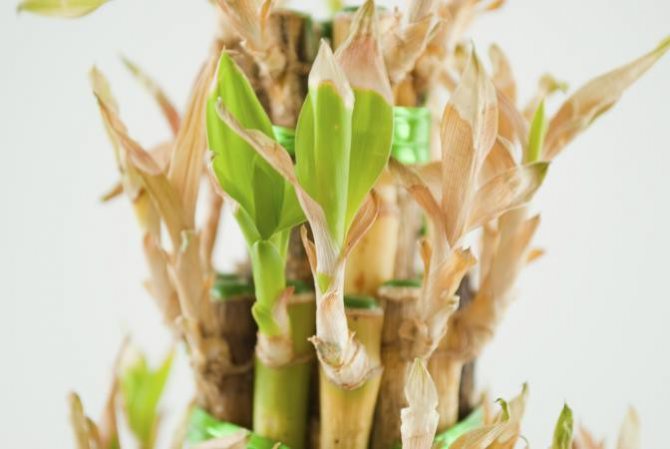

- If black spots or specks appear on the leaves, this indicates a fungal disease. In such cases, you need to treat the plant with fungicides. For preventive purposes, it is recommended to limit the number of airings in the room and reduce humidity.


- Darkening of the foliage and stem of the bamboo indicates hypothermia. The plant should be moved to another room.
- The plant withers after transplanting from water to soil. In this case, bamboo requires more abundant watering. This is due to the fact that the plant is accustomed to the constant presence of moisture, and it is difficult for it to change abruptly. Just 2-3 months bamboo needs to be watered as often and abundantly as possible.
Main characteristics
Indoor bamboo has no connection with a wild plant. The plant received this name for its visual similarity with a wild-growing species. Planting homemade bamboo, reproducing and caring for it is not difficult. The plant looks quite impressive: green bare stems, at the end of which there are shoots of different shapes.
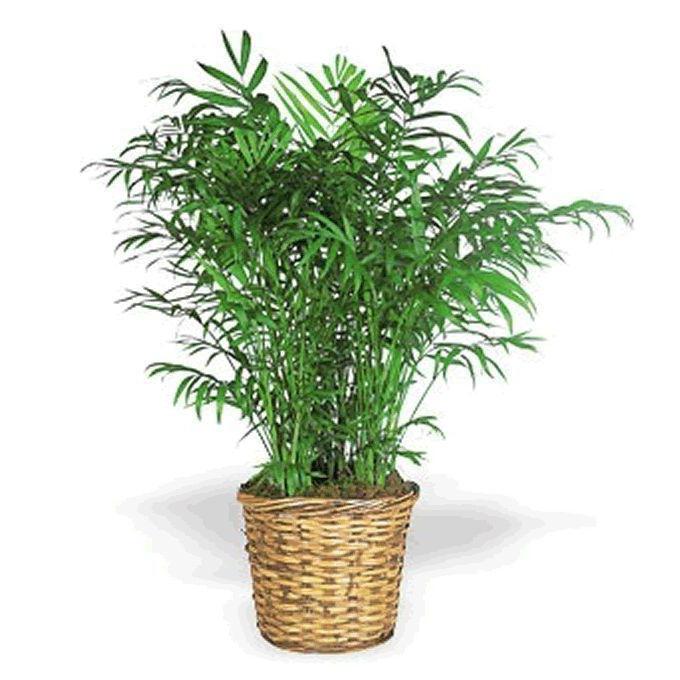

When properly cared for, bamboo has a deep green color. But it happens that it varies to straw shades.
Bamboo is also different in shape. The stems can be straight or twisted. Leaves can be narrow, wide, long, or short.
Bamboo is an ornamental plant that grows on average up to one meter in height. The growth rate of home bamboo is directly related to the quality of care.



